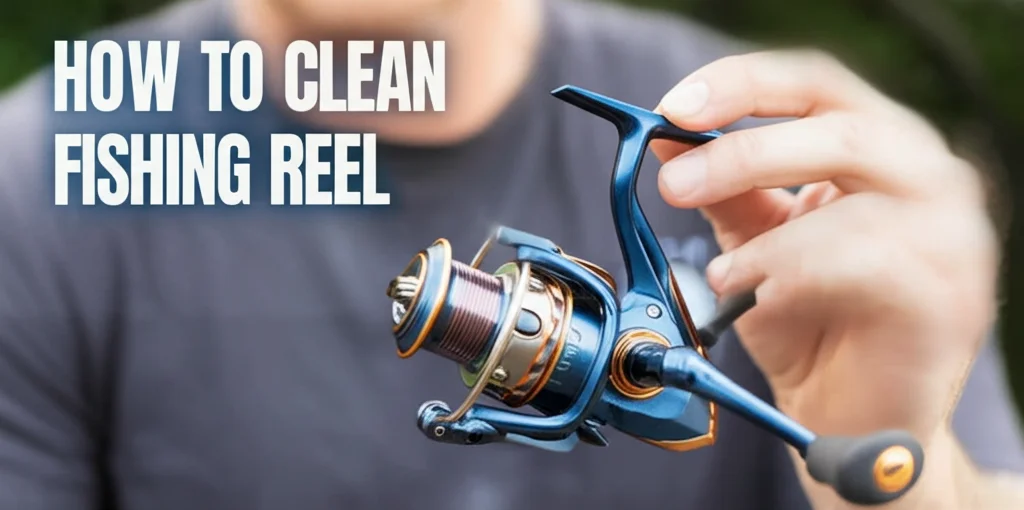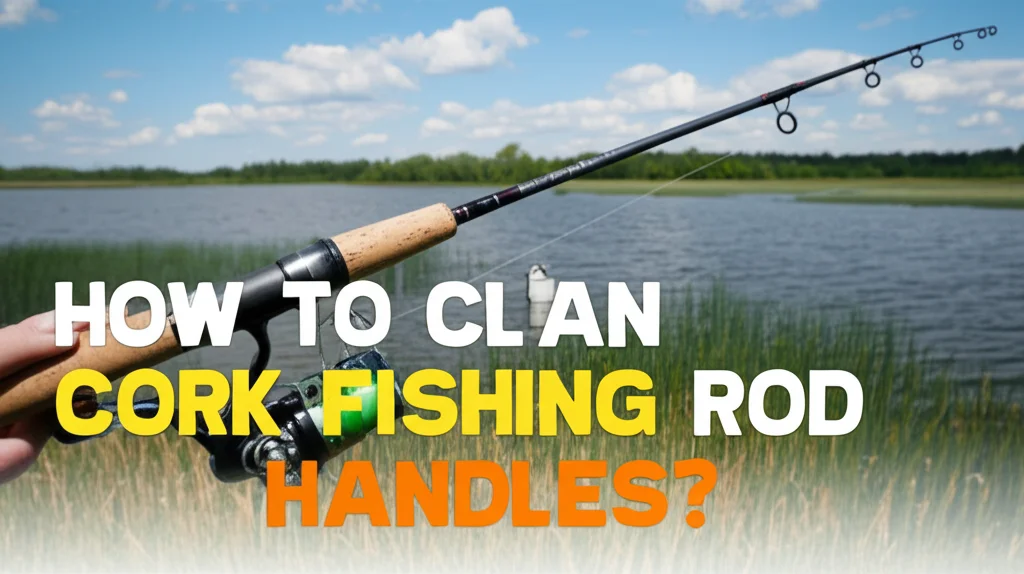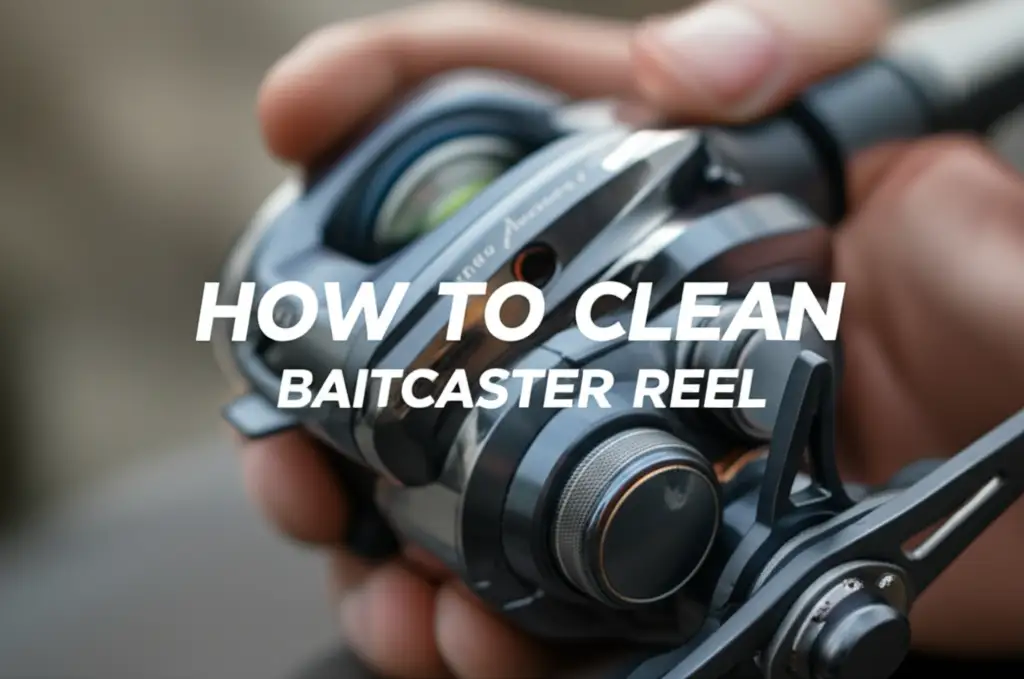· Outdoors & Recreation · 14 min read
How To Clean A Fishing Reel

The Ultimate Guide to Cleaning a Fishing Reel: Maintain Your Gear for Better Performance
Every angler knows that a clean fishing reel is essential for optimal performance and longevity. Whether you’re battling saltwater corrosion, dealing with sand infiltration, or simply performing routine maintenance, knowing how to clean a fishing reel properly can save you money and frustration in the long run.
A well-maintained reel casts smoother, retrieves better, and simply lasts longer—sometimes for generations. In this comprehensive guide, we’ll walk through everything you need to know about cleaning different types of fishing reels, from simple after-use rinses to deep cleaning procedures that will extend the life of your valuable equipment.
Key Takeaways
- Regular cleaning extends your fishing reel’s lifespan and maintains performance
- Different reel types (spinning, baitcasting, conventional) require specific cleaning approaches
- Saltwater fishing demands immediate cleaning after every use
- Quality lubricants and cleaning products make a significant difference
- Simple maintenance can prevent expensive repairs or replacements
In short: Cleaning your fishing reel involves disassembling the appropriate components, gently removing dirt and old lubricant, applying fresh oil and grease to moving parts, and reassembling carefully to ensure smooth operation.
Why Regular Reel Cleaning Matters
Regular maintenance of your fishing reel isn’t just about keeping it looking nice—it’s about protecting your investment and ensuring reliable performance when you need it most. The moving parts in a fishing reel operate in challenging environments, facing elements that can quickly degrade their functionality.
Benefits of Regular Cleaning
- Extended Lifespan: A well-maintained reel can last decades instead of just a few seasons
- Improved Performance: Clean gears and bearings mean smoother casting and retrieval
- Reduced Friction: Proper lubrication minimizes wear on moving parts
- Corrosion Prevention: Especially important for saltwater anglers
- Cost Savings: Regular maintenance costs far less than replacement or professional repairs
Most fishing experts recommend a quick rinse after each use and a thorough cleaning every 10-15 fishing trips for freshwater reels. For saltwater fishing, a thorough rinse is necessary after every trip, with deep cleaning recommended every 5-7 outings.
Neglecting reel maintenance can lead to seized bearings, corroded gears, and ultimately complete mechanical failure—often at the worst possible moment, like when you’re fighting that trophy fish you’ve waited all season to catch.
Essential Tools and Supplies for Cleaning Fishing Reels
Having the right tools on hand makes reel cleaning much easier and more effective. While you can improvise with household items, a dedicated fishing reel cleaning kit will provide better results and help avoid damage to delicate components.
Basic Cleaning Kit Components
- Small screwdrivers (Phillips and flathead in various sizes)
- Needle-nose pliers for handling small springs and components
- Soft-bristled toothbrush or dedicated reel cleaning brush
- Cotton swabs and microfiber cloths
- Reel oil (lightweight lubricant for bearings and fast-moving parts)
- Reel grease (heavier lubricant for gears and drag systems)
- Mild degreaser (specific for fishing reels)
- Compressed air (canned or small compressor)
- Small containers to organize parts during disassembly
- Tweezers for handling tiny components
Many manufacturers offer specific cleaning and lubricating products designed for their reels. While these often work best, quality third-party products like Ardent Reel Kleen, Penn Reel Lubricant, or Corrosion X can also provide excellent results.
For saltwater anglers, specialized products like Salt-X or Reel Magic offer additional protection against the harsh effects of salt exposure. These products help neutralize salt residue and provide a protective coating that repels moisture.
A helpful tip is to take photos of your reel at different stages of disassembly. This visual record can prove invaluable when you’re trying to remember how everything fits back together—especially for complex baitcasting reels with numerous small parts.
How to Clean a Spinning Reel: Step-by-Step Guide
Spinning reels are among the most popular and user-friendly reels, making them a great starting point for learning reel maintenance. Their relatively simple design makes cleaning manageable even for beginners.
Quick After-Use Maintenance
After each fishing trip, perform these simple steps to keep your spinning reel in good condition:
- Rinse with fresh water - Even if used in freshwater, give your reel a gentle rinse to remove dirt and debris
- Wipe down thoroughly - Use a soft cloth to dry the reel completely
- Spray light oil on exposed metal parts and moving components
- Store in a dry place away from extreme temperatures
Deep Cleaning Process
For a more thorough cleaning every 5-10 uses (more frequently for saltwater use), follow these steps:
- Gather your supplies and find a clean, well-lit workspace
- Remove the spool by unscrewing the drag knob at the top of the reel
- Clean the spool with a damp cloth and inspect the line for damage
- Wipe down the exposed reel body, paying special attention to the bail mechanism
- Remove side plate (if your model allows) by locating and removing the appropriate screws
- Clean all accessible gears and components using cotton swabs and degreaser
- Apply fresh oil to bearings and bushings—just a small drop is sufficient
- Apply grease to the main gear teeth and other gear contact points
- Reassemble the side plate and tighten screws carefully—avoid over-tightening
- Replace the spool and adjust the drag to minimum pressure for storage
During cleaning, pay special attention to the line roller (the small wheel at the end of the bail). This component often collects debris and requires regular cleaning and lubrication to prevent line damage and ensure smooth operation.
For spinning reels used in saltwater, consider soaking external components in a bucket of freshwater with a drop of mild dish soap before beginning your cleaning process. This helps dissolve salt deposits that might be difficult to see.
Remember that more isn’t always better when it comes to oil and grease—excess lubricant can attract dirt and actually cause more problems than it solves. A single drop of oil on bearings and a thin coat of grease on gears is typically sufficient.
Baitcasting Reel Cleaning and Maintenance
Baitcasting reels are more complex than spinning reels, with additional components that require special attention during cleaning. Learning how to clean a baitcasting fishing reel properly will help maintain its precision and performance.
Basic Exterior Cleaning
For routine maintenance after each use:
- Wipe down the exterior with a damp cloth
- Pay special attention to the level wind (line guide) area
- Check the handle knobs for dirt buildup and clean as needed
- Lightly oil external moving parts like handle connections and level wind
Complete Baitcaster Cleaning
For a thorough cleaning (recommended every 8-10 uses for freshwater, 3-5 for saltwater):
- Remove the side plates according to manufacturer instructions
- Take a photo of the internal components before proceeding further
- Remove the spool carefully, noting how it’s positioned
- Clean the spool and brake components with degreaser and cotton swabs
- Inspect the spool shaft and bearings for damage or excessive wear
- Clean all gears and internal components thoroughly
- Oil the bearings with 1-2 drops of quality reel oil
- Apply grease to gears sparingly, focusing on contact points
- Reassemble following your photos for reference
- Test the reel action to ensure smooth operation
When cleaning a baitcasting reel, be particularly careful with the brake system components, whether magnetic or centrifugal. These precision parts control your casting and require gentle handling. Some anglers prefer to leave one side of the reel assembled if they’re not experienced with the brake system maintenance.
For cleaning baitcasting reel bearings, some enthusiasts use specialized bearing cleaning kits that allow for thorough degreasing and re-lubrication. This can significantly improve casting performance, especially in higher-end reels.
If you notice significant wear on gears or other internal components during cleaning, consider ordering replacement parts rather than continuing to use damaged components. Manufacturers like Shimano, Daiwa, and Abu Garcia typically offer parts diagrams and replacement components for their reels.
Saltwater Reel Cleaning: Special Considerations
Saltwater fishing presents the most challenging environment for fishing reels, with salt and minerals that can rapidly corrode metal components. Learning how to clean a fishing reel after saltwater use is essential for preventing damage and extending the life of your equipment.
Immediate Post-Fishing Care
After every saltwater fishing session:
- Rinse thoroughly with fresh water while still assembled
- Pay special attention to rinsing around the drag adjustment, handle, and any openings
- Operate the reel while rinsing to help flush out salt from internal areas
- Wipe down completely with a soft cloth
- Allow to air dry completely before storage
Deep Saltwater Reel Cleaning Process
For thorough maintenance after multiple saltwater trips:
- Disassemble the reel more completely than you might for freshwater cleaning
- Soak non-electronic components in fresh water with a drop of dish soap
- Scrub lightly with a soft brush to remove salt deposits
- Pay special attention to screws and crevices where salt can accumulate
- Rinse components thoroughly with clean fresh water
- Dry completely using compressed air if available
- Apply corrosion inhibitor to metal surfaces before lubricating
- Use marine-grade lubricants specifically designed for saltwater use
- Reassemble carefully and test operation
Many serious saltwater anglers invest in ultrasonic cleaners for reel parts, which use high-frequency sound waves to remove salt from hard-to-reach areas. While not essential, this equipment can be valuable for maintaining expensive saltwater fishing reels.
For reels with sealed drag systems (common in high-end saltwater models), avoid disassembling the drag unless absolutely necessary. These sealed systems are designed to keep salt out, and improper reassembly can compromise their integrity.
Conventional “round” reels often used for offshore saltwater fishing typically have simpler designs than baitcasters but require the same diligent cleaning. Their larger components and sturdier construction make them somewhat easier to maintain despite the harsh saltwater environment.
Troubleshooting Common Reel Problems During Cleaning
Cleaning your fishing reel provides an excellent opportunity to identify and fix common issues before they develop into serious problems. Here are some issues you might encounter and how to address them:
Sandy Reels: Removing Grit and Debris
Sand is particularly damaging to fishing reels, as it can act like sandpaper on moving parts. If you’re wondering how to clean sand from a fishing reel:
- Don’t rotate the handle until cleaned, as this grinds sand into components
- Soak the exterior in warm water to loosen sand particles
- Use compressed air to blow out sand from crevices
- Disassemble more thoroughly than usual to access sand-affected areas
- Rinse components repeatedly until all grit is removed
- Dry thoroughly before lubricating and reassembling
Handling Corroded Parts
If you discover corrosion during cleaning:
- For light surface corrosion, use a soft brush with mild vinegar solution
- For seized components, apply penetrating oil and allow to sit before attempting to loosen
- Severely corroded parts should be replaced rather than salvaged
- Check nearby components for damage from corrosion byproducts
- Apply corrosion inhibitor after cleaning to prevent future issues
Dealing with Sticky Drag Systems
A sticky or jerky drag often indicates cleaning is needed:
- Access the drag washers according to your reel’s design
- Inspect for dirt, salt, or old grease accumulation
- Clean with appropriate solvent recommended by the manufacturer
- Apply specific drag grease if recommended (many modern drag washers work best dry)
- Reassemble in the correct order (take photos before disassembly)
Remember that modern carbon fiber drag washers often perform best without any lubricant, while older felt washers typically require specific drag grease. Always check your manufacturer’s recommendations.
Professional Cleaning vs. DIY: When to Seek Expert Help
While regular DIY maintenance is essential, there are times when professional service makes sense. Professional reel cleaning services have specialized tools and expertise for complex issues.
When to Consider Professional Service
- After significant saltwater exposure if you’re not experienced with full disassembly
- For high-end reels worth several hundred dollars
- When you encounter mechanical problems you can’t identify
- If you hear unusual noises like grinding or clicking
- After dropping or damaging your reel
- For vintage or collectible reels with historical value
- When preparing for an important fishing trip or tournament
Professional services typically cost between $25-75 depending on the reel type and service level, which is significantly less than replacing a damaged reel. Many fishing shops offer basic cleaning services, while manufacturer service centers provide more comprehensive overhauls.
If you decide to use a professional service, ask about their cleaning process, turnaround time, and warranty on their work. Reputable services should be willing to explain their methods and stand behind their results.
For those interested in learning more advanced maintenance skills, some tackle shops and fishing clubs offer reel cleaning workshops where you can learn proper techniques under expert guidance.
Preventative Maintenance and Best Practices
The best approach to reel cleaning is preventing excessive contamination in the first place. These preventative measures can reduce the frequency and intensity of cleaning needed:
Daily Fishing Habits
- Avoid laying reels in sand or dirt when changing lures or handling fish
- Keep reels out of saltwater whenever possible
- Rinse with fresh water after each use, especially in saltwater
- Store rods and reels vertically when not in use during fishing
- Use reel covers when transporting equipment
Long-term Storage Tips
- Back off the drag to reduce pressure on internal components
- Clean thoroughly before extended storage
- Store in climate-controlled environment away from extreme temperatures and humidity
- Consider removing line from reels stored for several months
- Apply slightly more lubricant than usual for storage to prevent corrosion
- Check periodically during storage and rotate handles occasionally
Protecting Electric Fishing Reels
For those wondering how to clean an electric fishing reel, these specialized units require extra caution:
- Never submerge the motor housing
- Use damp cloths rather than direct water for exterior cleaning
- Pay special attention to seals around the motor housing
- Follow manufacturer guidelines for accessing serviceable parts
- Consider professional service more frequently for these complex reels
Electric reels often come with specific maintenance guidelines from manufacturers like Shimano, Daiwa, or Penn. These should be followed carefully to avoid damaging sensitive electronic components.
FAQ: Common Questions About Reel Cleaning
What is the best thing to clean fishing reels with?
For most cleaning purposes, a mild degreaser specifically formulated for fishing reels works best. Products like Ardent Reel Kleen, Penn Rod & Reel Cleaner, or even a diluted solution of Simple Green are effective. Avoid harsh solvents like acetone or brake cleaner, which can damage plastic and sealed components. Always follow up cleaning with appropriate lubricants for moving parts.
How do you clean a reel after use?
After each use, wipe down your reel with a soft cloth, spray lightly with freshwater (especially after saltwater use), and dry thoroughly. Operate the reel while rinsing to help water penetrate into crevices. Apply a light coat of protective spray like Reel Magic or WD-40 Specialist Corrosion Inhibitor (not regular WD-40) to exterior metal parts after drying.
How to clean sand from a fishing reel?
For sand removal, avoid turning the handle until cleaned, as this presses sand into the gears. Rinse thoroughly with freshwater without spinning the reel, then use compressed air to blow out sand from crevices. For significant sand infiltration, partial disassembly may be necessary to clean internal components properly before damage occurs.
How to clean an electric fishing reel?
Electric reels require special care. Never submerge the motor housing in water. Clean exterior surfaces with a damp cloth and mild cleaner. For internal components, follow the manufacturer’s maintenance guide carefully. Many electric reel manufacturers offer specific cleaning kits and instructions for their models. When in doubt, seek professional service for these expensive specialized reels.
How often should I clean my fishing reel?
Freshwater reels typically need a quick cleaning after each use and deep cleaning every 10-15 outings. Saltwater reels require thorough rinsing after every use and deep cleaning every 3-5 trips. Reels stored for long periods should be cleaned before storage and checked periodically. Your fishing frequency, conditions, and reel quality will affect the ideal cleaning schedule.
Can I use WD-40 on my fishing reel?
Standard WD-40 is not recommended for fishing reels as it’s primarily a water dispersant, not a lubricant, and can wash away existing lubrication. For exterior protection, WD-40 Specialist Corrosion Inhibitor can be used on exterior metal surfaces only. For moving parts, use specific reel oils and greases designed for fishing equipment.
Final Thoughts on Reel Maintenance
Learning how to clean a fishing reel properly is an investment in your fishing future. While it might seem tedious at first, regular maintenance quickly becomes a rewarding part of the fishing experience—a ritual that connects you more deeply to your sport and equipment.
Remember that different reels have different needs. A high-end baitcaster deserves more attention than an entry-level spinning reel, and saltwater demands more rigorous cleaning than freshwater. Adapt your maintenance routine to match your specific equipment and fishing conditions.
As you become more familiar with your reels’ internal workings through regular cleaning, you’ll develop a better understanding of how they function. This knowledge not only helps with maintenance but can improve your fishing technique as well.
Consider creating a simple maintenance log for your valuable reels, tracking when you perform deep cleanings and any parts you replace. This record can help identify patterns and prevent problems before they develop.
Whether you’re preserving a cherished reel passed down through generations or maintaining a new investment, proper cleaning techniques will ensure your equipment is ready whenever that perfect fishing opportunity arises. Take care of your reels, and they’ll take care of you on the water for years to come.
- fishing reel maintenance
- reel cleaning
- fishing gear care
- saltwater reel cleaning
- freshwater reel cleaning




